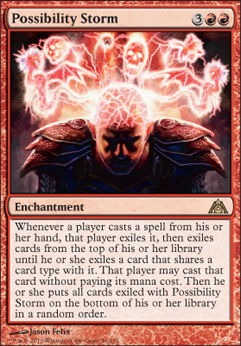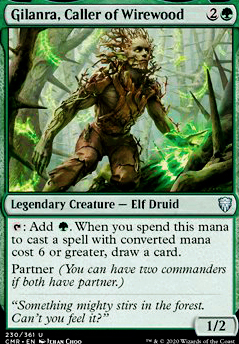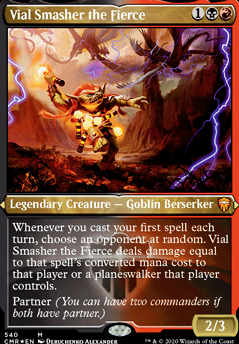Mulligans
A big benefit of the "every card a banger" philosophy is that you don't have to worry about your starting hand too much. If you have access to all three colors of mana in your starting hand, you're almost guaranteed to be alright. I would mulligan if I have no green lands or only 2 lands and no ramp. Ideally you will have lands providing all 3 colors and a Birds of Paradise or similar. Almost nothing beyond that matters, but some of the Shenanigans or cheaper "Card Advantage" cards are extra gravy.
Early Game: Turns 1-3
If you have the ramp, you'll get out one commander on turn 2 and the other on turn 3. I typically put out Gilanra, Caller of Wirewood first for two reasons. The first is the mana ramp, and the second is that it's less scary to the table than getting Vial Smasher the Fierce out too early. You don't want to make yourself an archenemy target until it's too late. Putting out Vial Smasher on turn 2 is only going to get you an extra 3 damage when you cast Gilanra on turn 3, and that's not going to make a difference in a couple of turns, but it might be enough to get a focus on you. Worst case, you typically get them both out by turn 4, and it's reasonable to expect that you'll catch up on the ramp and get back on track in the mid game.
Mid Game: Turns 4-6
This is where you want your Shenanigans cards to show up. While no single one is critical, getting some of them will be instrumental for the late game triggers to win. Remember to tap Gilanra for mana for anything costing over 6 to get that card draw, and along with Shenanigans cards, prioritize putting out any cards that give you access to more cards (Keen Duelist), anything that casts for free (Wondrous Crucible), and anything that starts thinning the lands (Verdant Mastery or low mana value cards (Chimil, the Inner Sun out of your library. When you search for lands, prioritize other fetches first, and pay attention to what they can fetch- don't waste Bloodstained Mire on a basic swamp when you could get Blood Crypt or Ziatora's Proving Ground.
Late Game: Turns 7-10
The late game will snowball very hard, very suddenly. It's not a combo deck in the traditional sense, but it does rely on the synergy of cards already mentioned. The strengths are that the "combo pieces" are extremely interchangeable, with many cards pairing well with many others, so non-board wipe removal is hard for opponents to use to pin down the key pieces. Even the commanders, while an important part, aren't the only part. And most of the effects are dependent on you casting spells (see Possibility Storm), but aren't dependent on them resolving, so it's hard for opponents to slow down outside of stax decks that only let you cast spells from your hand to begin with.
While you might get an extra card or two in the mid game from one or two cards like Wild-Magic Sorcerer, by around turn 7 you're probably going to have cascaded into something like Nalfeshnee that's going to synergize with these effects and increase their value literally exponentially. This means that turns 8 and 9 are probably going to have tons of triggers, tons of cards in exile that you can cast, and tons of cascades, duplications, and possibility storms. The library can routinely get down to under 50 cards on turn 8, and by turn 10 there's a real possibility of emptying your library completely. Fortunately very few of your cards actually draw you a new card, and you're almost certainly going to have won by the end of the turn that you deck yourself.
On that note, the win condition: noncombat damage. Whether it's from Vial Smasher the Fierce, Passionate Archaeologist, Keeper of Secrets, or the Treacherous Terrain you cast and copied after Avatar of Growth gave everyone the impression they were keeping up with you, things are going to be dealing damage left and right. It's death by a thousand ~~cuts~~ massive wounds. And if those don't deal quite enough noncombat damage, you've probably accidentally ended up with Ghalta, Primal Hunger with his big power and trample or Nalfeshnee with flying on the battlefield, so swinging in for the combat damage coup de grâce, while unlikely to be needed, is definitely an option. Don't forget that you may have some odd bonuses, like Scion of Draco granting lifelink to Vial Smasher, or Tavern Brawler occasionally giving both commanders huge power boosts. Important note: there is a lot to keep track of in these last few turns. Be sure to keep track of what spells are cast vs only copied (relevant to Keeper of Secrets, for example), where things are on the stack with cascade triggers and copied spells, and triggers in general, between all of the cards that give you extra exiled card options on upkeep, revealing at the end of the turn, revealing and casting automatically in your upkeep, etc.



